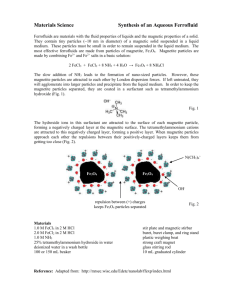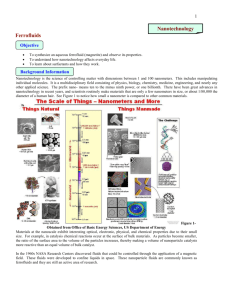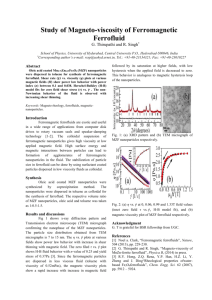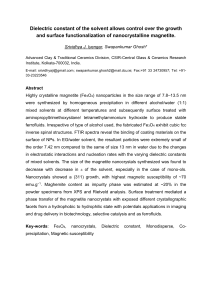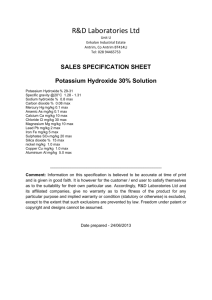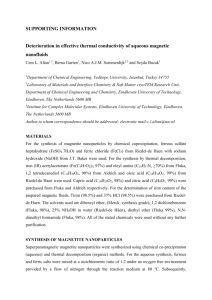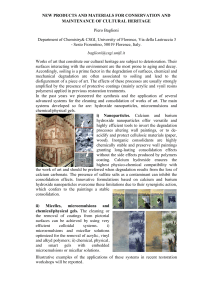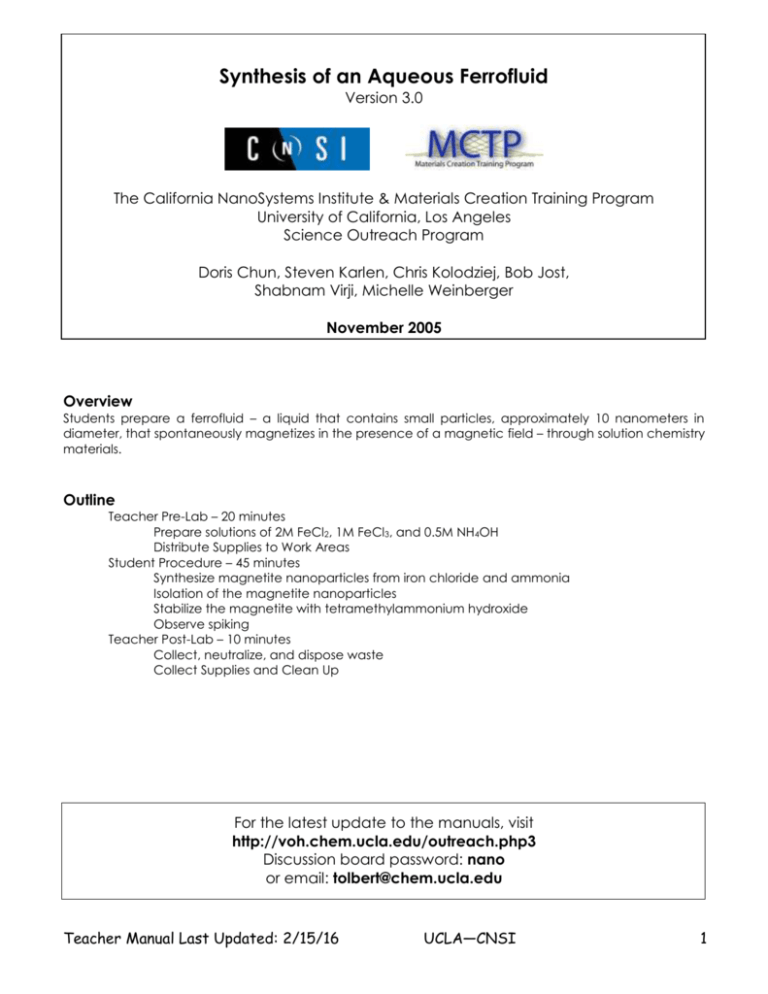
Synthesis of an Aqueous Ferrofluid
Version 3.0
The California NanoSystems Institute & Materials Creation Training Program
University of California, Los Angeles
Science Outreach Program
Doris Chun, Steven Karlen, Chris Kolodziej, Bob Jost,
Shabnam Virji, Michelle Weinberger
November 2005
Overview
Students prepare a ferrofluid – a liquid that contains small particles, approximately 10 nanometers in
diameter, that spontaneously magnetizes in the presence of a magnetic field – through solution chemistry
materials.
Outline
Teacher Pre-Lab – 20 minutes
Prepare solutions of 2M FeCl2, 1M FeCl3, and 0.5M NH4OH
Distribute Supplies to Work Areas
Student Procedure – 45 minutes
Synthesize magnetite nanoparticles from iron chloride and ammonia
Isolation of the magnetite nanoparticles
Stabilize the magnetite with tetramethylammonium hydroxide
Observe spiking
Teacher Post-Lab – 10 minutes
Collect, neutralize, and dispose waste
Collect Supplies and Clean Up
For the latest update to the manuals, visit
http://voh.chem.ucla.edu/outreach.php3
Discussion board password: nano
or email: tolbert@chem.ucla.edu
Teacher Manual Last Updated: 2/15/16
UCLA—CNSI
1
California State Science Standards Grades 9-12
Addressed by the Solar Cell Experiment
Physics
1m. *Students know how to solve problems involving the forces between two electric charges at a
distance (Coulomb's law) or the forces between two masses at a distance (universal gravitation).
5j.
*Students know electric and magnetic fields contain energy and act as vector force fields.
5f.
Students know magnetic materials and electric currents (moving electric charges) are sources of
magnetic fields and are subject to forces arising from the magnetic fields of other sources.
Ferromagnetism is the permanent magnetic dipole that results from the alignment of unpaired electron
spins in elements such as iron, cobalt, nickel, etc. In this experiment, students will experiment with a fluid
they create that exhibits ferromagnetism. They will synthesize magnetic nanoparticles from iron chlorides
and disperse them into a tetramethylammonium hydroxide surfactant to form a colloidal suspension.
They will then study the behavior of this ferrofluid in the presence of an external magnetic field.
Discussion questions 3, 4, and 5 relate to the concept of
Coulomb’s Law, which describes the magnitude of
electrostatic force, repulsion or attraction, between two
charged particles at a finite distance. The tetramethylammonium hydroxide surfactant used in this experiment is
composed of two charged species, (CH3)4N+ and -OH. The
hydroxide anions adhere to the surface of magnetite
particles, and these negative charges attract their counter
ions, tetramethylammonium cations, forming a positively
charged outer shell.
Since like charges repel, the
electrostatic repulsion between positively charged outer
shells prevent magnetite particles from agglomerating. This
results in a colloidal suspension of magnetite nanoparticles,
which is what we called a ferrofluid. Discussion question 6
deals with magnetic fields and vector force fields.
Ferromagnetic materials respond to external magnetic
fields by aligning their unpaired electron spins with the
vector fields. When a magnet is far away from the solution,
no external vector fields interact with the ferrofluid, thus
there is nothing interesting to see except a black solution.
When a magnet is brought closer to the solution, the
magnetic force is large enough to dominate the forces of
surface tension and gravity, the ferrofluid forms spikes in the
direction of the magnetic field lines. The stronger the
vector field lines, the larger the spikes.
Nano particle picture from: Berger, P.; Adelman, N. B.; Beckman, K. J.; Campbell, D. J.; Ellis, A. B.; Lisensky,
G. C. J. of Chemical Education 1999, 76, 943-8.
Teacher Manual Last Updated: 2/15/16
UCLA—CNSI
2
Chemistry
2f.
2h.
5a.
6a.
6b.
6d.
*Students know how to predict the shape of simple molecules and their polarity from Lewis dot
structures.
*Students know how to identify solids and liquids held together by van der Waals forces or hydrogen
bonding and relate these forces to volatility and boiling/ melting point temperatures.
Students know the observable properties of acids, bases, and salt solutions.
Students know the definitions of solute and solvent.
Students know how to describe the dissolving process at the molecular level by using the concept
of random molecular motion.
Students know how to calculate the concentration of a solute in terms of grams per liter, molarity,
parts per million, and percent composition.
The formation of ferrofluid involves various types of forces that hold the different components together.
On the molecular level, magnetite (Fe3O4) is held together by ionic interactions in the crystal lattice, while
tetramethylammonium and hydroxide are covalent molecules held together by ionic interactions. Ionic
attractions between hydroxide anions and tetramethylammonium cations enable the coating of
magnetite nanoparticles, while electrostatic interparticle repulsions among tetramethylammonium
cations allow colloidal suspension of the magnitite in solution. Without tetramethylammonium hydroxide
as a surfactant, magnetite nanoparticles tend to aggregate due to van der Waals forces. Therefore, it is
critical to have the appropriate surfactant to stabilize an aqueous ferrofluid. In this experiment, students
will learn that these forces are responsible for the formation of ferrofluid.
Discussion questions 7, 8, and 9 deal with basic quantitative chemistry in which students practice
balancing equations, determining oxidation state in metals, and calculate solution concentrations.
Students can also practice writing out the Lewis dot structures of chemicals used in this experiment to
identify their charges, for example (CH3)4N+ and –OH. Discussion question 10 deals with the packing and
layer sequence of magnetite in the crystal lattice.
Investigation and Experimentation
1b.
1c.
1d.
Identify and communicate sources of unavoidable experimental error.
Identify possible reasons for inconsistent results, such as sources of error or uncontrolled conditions.
Formulate explanations by using logic and evidence.
Discussion questions 1 and 2 address the importance of adding ammonium hydroxide at a slow rate in
the early stage of the experiment. In order for magnetite particles to remain in suspension their diameters
must be on the order of 10nm (100Å) or less. By adding ammonium hydroxide slowly, one can ensure
nanoscale particle formation. If ammonium hydroxide was added too quickly, large chunks of magnetite
will form instead of the desired nanoparticles, consequently the experiment will fail. Toward the end of
the synthesis, it is important to decant excess liquid out of the ferrofluid such that it has the right viscosity
to form spikes in response to a nearby magnetic field. If the ferrofluid has too much excess liquid in it, it
will not form spikes. Experiment with the ferrofluid by placing the magnet under the solution. If no spikes
form, continue decanting until the right viscosity is achieved.
Teacher Manual Last Updated: 2/15/16
UCLA—CNSI
3
*****Tip for Teachers*****
Read the entire teachers manual before you begin this experiment with your students! There are a
number of ways in which students may be assessed on this experiment. You may choose to assign some
of the discussion questions from the student manual for credit, you may ask the students to keep a lab
notebook, or you may ask the students to prepare a lab report.
Ferrofluid Supplies List
Reusable Supplies Included in Kit:
40 Safety Glasses
250 mL Plastic Bottle
125 mL Plastic Bottle
2 L Plastic Jug
100 mL Graduated Cylinder
9 (10 mL) Graduated Cylinders
~70 (150 mL) Plastic Beakers
~300 Large Weigh Boats
~100 Pipettes
20 Magnets
1 Stainless Steel Scoopula Spatula
3 pk Gloves
Consumable Supplies Included in Kit:
(Reorder requests: http://voh.chem.ucla.edu/outreach.php3)
500g FeCl3•6H2O (Ferric Chloride)
200g FeCl2•4H2O (Ferrous Chloride)
500 mL Ammonium Hydroxide (29%)
220 mL Tetramethylammonium Hydroxide
500 g Citric Acid
pH paper
Supplies to be Obtained by Teacher:
Distilled Water
Each Group of 2-5 Students Will Need:
3 Plastic Beakers (150 mL)
1 Pasteur Pipette
1 Large Weigh Boat
1 Magnet
Teacher Manual Last Updated: 2/15/16
UCLA—CNSI
4
Teacher Pre-Lab – 20 Minutes
Prepare the FeCl2, FeCl3, and NH4OH Solutions
The empty 250 mL bottle will be used for the 1M FeCl 3 solution. The empty 125 mL bottle will be used for
the 2M FeCl2 solution. To prevent oxidation of FeCl2, minimize exposure of FeCl2 solid and solution to air by
keeping bottles capped when not in use. The 2L jug will be used for the 0.5M ammonium hydroxide
solution. Two liters is enough for 40 experiments. If over 40 experiments are needed, use a larger
container if available, or split the solution into 2 batches: preparing the second after the first is consumed.
The experiment should be done with 2-5 students per experiment. The teacher will determine how many
experiments are required given class sizes, student attention, and time. For solution prep calculations,
adding excess experiments (~10%) to the minimum # of experiments required would be a good idea,
allowing for spills/ accidental overuse of certain reagents.
1M FeCl3: 1.0813 g of FeCl3•6H2O is required for each experiment. Therefore:
# of Experiments X 1.0813 = Grams FeCl3•6H2O Required for Teacher to Measure
FeCl3•6H2O solution requires 4 mL of water per experiment. Therefore:
# of Experiments X 4 = mL Water Required for the FeCl3 Solution
2M FeCl2: 0.39762 g of FeCl2•4H2O is required for each experiment. Therefore:
# of Experiments X 0.39762 = Grams FeCl2•4H2O Required for Teacher to Measure
FeCl2•4H2O solution requires 1 mL of water per experiment. Therefore:
# of Experiments X 1 = mL Water Required for FeCl2 Solution
0.5M Ammonium Hydroxide: 1.6667 mL of concentrated (29%) Ammonium Hydroxide is required for each
experiment. Therefore:
# of Experiments X 1.6667 = mL Concentrated Ammonium Hydroxide Required
for Teacher to Measure
0.5M Ammonium Hydroxide requires dilution to 50 mL per experiment. Therefore:
# of Experiments X 50 = Total Volume to Dilute Concentrated Ammonium
Hydroxide (Affords 0.5M Solution)
Teacher Manual Last Updated: 2/15/16
UCLA—CNSI
5
Distribute the Supplies
Each Group of 2-5 Students Should Have:
2 Graduated Cylinders (10 mL)
3 Plastic Beakers (150 mL)
1 Pasteur Pipette
1 Large Weigh Boat
1 Magnet
Set Up FeCl3 Station With:
250 mL Bottle of 1 M FeCl3
Several Plastic Pipettes
4 Graduated Cylinders (10 mL)
Set Up FeCl2 Station With:
125 mL Bottle of 2 M FeCl2
Several Plastic Pipettes
4 Graduated Cylinders (10 mL)
Set Up NH4OH Station With:
2 L Jug of 0.5 M NH4OH
(If time is an issue, this station can be pre-poured 150 mL beakers of 50 mL 0.5 NH4OH)
Set Up Rinse Water Station With:
Distilled Water (NOT Tap Water)
(If time is an issue, this station can be pre-poured 150 mL beakers of 50 mL H2O)
Set Up (CH4)4NOH Station With:
250 mL Bottle of tetramethylammonium hydroxide
Several Plastic Pipettes [only use these pipettes with (CH4)4NOH]
*****Tip for Teachers*****
When preparing the FeCl2, FeCl3, and NH4OH solutions we recommend preparing an excess 10%, this will
allow for any spills or accidental overuse of the reagents that might occur. The four solution stations
should be in different parts of the classroom, this will help to keep a flow to and from the reagents to a
minimum. Also, if time is an issue, pre-pour the NH4OH and distilled water into beakers for your students.
Teacher Manual Last Updated: 2/15/16
UCLA—CNSI
6
Student Procedure – 45 Minutes
Note: Procedure contains more detail and advanced terminology than the student manual
A
B
C
Preparation of the Ferrofluid
1.
Add 4 mL of the FeCl3 solution (0.004 mol) and 1 mL of the FeCl2
solution (0.002 mol) to a 150 mL beaker.
2.
While swirling the iron chloride solution, slowly add 50 mL of 0.5
M ammonium hydroxide dropwise over 5 minutes. Picture A It is
important that the ammonium hydroxide is added dropwise,
especially at the beginning. The students can add the ammonium
hydroxide more quickly at the end (the last 10-20 mL) if they are
short on time.
3.
A black precipitate should form during the slow addition. This is
magnetite. Picture B The students should see this precipitate
form with the first drops of ammonium hydroxide, however as
long as the students add the ammonia slowly at first these will be
small particle that will dissolve back into solution.
4.
After all the ammonium hydroxide has been added, stop swirling.
5.
Place one of the bar magnets under the beaker. It should pull all
of the magnetite out of the solution, and the water should
become clear. Picture C
6.
Keeping the magnet on the bottom of the beaker, pour off the
excess water. This technique is called decanting. If the magnet
is removed then the particles will pour off into the waste
container.
7.
Add a minimal amount of water and transfer the magnetite to a
weigh boat. Students may want to use a second portion of water
to help transfer all the particles to the weighboat.
8.
Place the magnet under the weigh boat to settle the magnetite.
9.
Pour off the excess water.
10. Rinse the magnetite two more times by adding a small amount of
water, using the magnet to settle the magnetite, and discarding
the clear water. These rinsings remove the excess ammonium
hydroxide from the particles.
11. Remove as much water as necessary to form a viscous fluid. Be
careful NOT to remove all of the water, or you will form a solid.
The sample has the correct consistancy when there is no flow of
nanoparticles when the weigh boat is turned sidways and the
magnet is removed. It is important to achieve this consistancy
before stabilizing the ferrofluid. Once stabilized the magnetite
nanoparticles become water soluble and will be lost when
removing off excess water.
Teacher Manual Last Updated: 2/15/16
UCLA—CNSI
7
12. Add 1 mL of the 25% tetramethylammonium hydroxide solution,
and mix the ferrofluid for 2 minutes by moving the weigh boat
over the magnet.
D
13. Once thoroughly mixed, place the magnet under the weigh boat
and remove the excess black liquid into an empty beaker, as you
did before during the rinsing.
We recommend having the
students use the empty rinse water beaker just incase they pour
off too much of the ferrofluid.
14. Place the magnet under the ferrofluid and move it until you see
spiking. Picture D You may want to ask your students to bring
magnets from home for this experiment. Different magnets will
have different field lines.
NOTE: The ferrofluid is extremely difficult/impossible to remove from clothing. It is also difficult to remove from
magnets. Students should take care to avoid direct contact of the ferrofluid with clothing and magnets.
Teacher Post-Lab – 10 Minutes
Collect, Neutralize, and Dispose of Waste
Collect the waste from all the experiments in a large container and neutralize the base with citric acid.
Once the pH is between 6 and 10 you can pour waste down the drain followed by plenty of water (to
ensure that all suspended solids are flushed down the drain). The pH can be measured using the pH
paper provided in the kit, there is a color scale on the side of the pH paper container.
Suggested Topics for Discussion
1. What is the molarity of the FeCl3 and FeCl2 solutions?
1M for FeCl3 and 2M for FeCl2.
2. Why do you think slow (dropwise) addition of ammonium hydroxide is important? What might happen
if you add ammonium hydroxide quickly?
The ammonium hydroxide solution is added slowly to ensure nanoscale particle formation, rather
than formation of large chunks of magnetite. Thus, if it is added quickly, large chunks of
magnetite will form instead of the desired nanoparticles.
3. Magnetite, Fe3O4, consists of iron in what oxidation states?
Oxidation states of iron are +2 and +3.
4. . Why do you place a magnet underneath the beaker while removing water?
In the presence of a magnetic field (i.e. a magnet) the magnetite is magnetic. By placing a
magnet underneath the beaker, the magnetite is attracted to magnet and product loss is
minimized while the water is removed.
Teacher Manual Last Updated: 2/15/16
UCLA—CNSI
8
5. What is the purpose of the stabilizing agent tetramethylammonium hydroxide? What might happen if
NO stabilizing agent is used?
Tetramethylammonium hydroxide is a stabilizing ligand that is used to keep the nanoparticles in
solution and from sticking to each other. That is, it adheres to the particles creating a net
repulsion between them so the particles do not agglomerate. In the absence of a stabilizing
agent the particles will agglomerate. These conglomerates will then precipitate from the solution
as a black solid.
6. Describe what happens when a magnet is brought near a ferrofluid. What happens when the magnet
is removed from the ferrofluid?
When the magnet is far away from the solution there is nothing interesting to see except a black
solution. When the magnet is brought closer to the solution then you see spikes corresponding to
the magnetic field lines. The stronger the field lines, the lager the ferrofluid spikes along the line.
9. ADVANCED: Balance the following equation.
2FeCl3 + FeCl2 + 8NH3 + 4H2O
Fe3O4 + 8NH4Cl
10. Chemistry classes may wish to discuss the crystal packing of magnetite, shown below. 2
This is one of the crystallographic planes of the magnetite crystal lattice.
In this diagram there is a ratio of 2 Fe+3 : 1 Fe+2 : 4 O-2
Teacher Manual Last Updated: 2/15/16
UCLA—CNSI
9
Further Disscussion
Topics for Advanced Students
What is a Ferrofluid?
A ferrofluid is a collection of superparamagnetic nanoparticles that are suspended in a liquid.
These nanoparticles are approximately 10 nm in diameter. The majority of nanoparticles, like the ones
you make in this lab, are iron-based, such as magnetite (Fe3O4). If as-synthesized nanoparticles are put
into solution, they aggregate and form clusters due to van der Waal interactions. These clusters are too
large to be kept in suspension by Brownian motion and settle to the bottom of the container. The use of a
magnet can accelerate the settling of these clusters allowing for easy washing of the particles.
Nanoparticles will remain suspended in a solution as long as they do not aggregate. A technique to
prevent aggregation is to ‘stabilize’ the particles by encapsulating them with an outer shell. The general
method to achieve this is to use a surfactant. Surfactants are molecules with two contrasting properties.
They can be a linear molecule with a hydrophilic region and a hydrophobic region, or a cation anion
pair. The former works by having the hydrophilic end of the molecules attach to the magnetite
nanoparticles positioning the hydrophobic end to form a ‘greasy’ layer around the particle. This ‘greasy’
layer prevents nanoparticles from getting close enough to each other to aggregate. The later is the
method used in this experiment. The ion pair keeps particles separated through Coulombic repulsion by
encapsulating the particles with a cationic outter shell. The anions adhere to the surface of the
magnetite nanoparticles, and they attract its counter cations to form the positively charged outer shell.
Since like charges repel, the positively charged outer shell prevent magnetite nanoparticles from
aggregating.
Applications of Ferrofluids
There are many applications of ferrofluids. Most applications are based on these properties:
1) The ferrorfluid will go to where the strongest magnetic field is and stay there (this is called
localizability).
2) Ferrofluids absorb electromagnetic energy at convenient frequencies and heat up.
3) The physical properties of ferrofluids change when a magnetic field is applied.
Teacher Manual Last Updated: 2/15/16
UCLA—CNSI
10
Mechanical Applications
Ferrofluids are used as seals in gas lasers, motors, and blowers. In these applications the ferrofluid is
held in place by a strong magnet and separate two different pressured chambers. They have also been
used to as a media for vibrational dampaning in electronic applications, such as hard drives, graphic
plotters, and instrument gauges. Ferrofluids are also found in almost all high power loudspeakers. The
ferrofluid is kept in place by the magnet on the horn of the loudspeaker, and serves to seal the speaker
chamber, cool the speaker, and dampen unwanted overtones. 1
Medical Applications
There is also a substantial interest in using ferrofluids for medical applications. For example, if a drug
used to treat cancer was injected into a person with the ferrofluid, a magnetic field could be used to
focus the drug onto the tumor. Or, a ferrofluid, once injected, could be easily heated locally to burn a
tumor. These methods have already been successful at destroying cancers in rats.
Other Application
Perhaps one of the most interesting applications is in ink; ferrofluid based ink is used by the US
government to print the one dollar bill.2 This helps the government to identify counterfeit bills.
Teacher Manual Last Updated: 2/15/16
UCLA—CNSI
11
References
1. Rosensweig, R. E. Scientific American 1982, 247(4), 136-45.
2. Berger, P.; Adelman, N. B.; Beckman, K. J.; Campbell, D. J.; Ellis, A. B.; Lisensky, G. C. J. of Chemical
Education 1999, 76, 943-8.
3. http://www.mrsec.wisc.edu/EDETC/cineplex/index.html
4. Scherer, C. and Neto, A.M.F. Brazilian Journal of Physics, 35, 3A, 718 (2005).
5. Odenbach, S. Journal of Phys. Cond. Matter., 16 (2004), 1135.
6. Here are some web sites with more information on magnetism:
http://solar-center.stanford.edu/magnetism/introduction.html
http://www.school-for-champions.com/science/magnetism.htm
Adapted from
The Institute For Chemical Education
Department of Chemistry
University of Wisconsin, Madison
http://ice.chem.wisc.edu
Copyright © 2003 by Sarah Tolbert. All rights reserved; revised 2007
Teacher Manual Last Updated: 2/15/16
UCLA—CNSI
12


